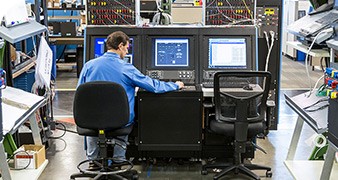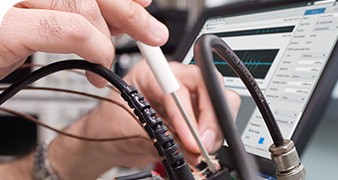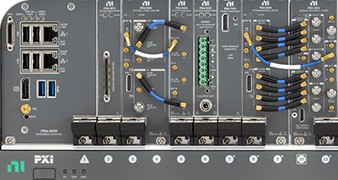Taking Measurements with NI Digital Multimeters
At the end of this course, you will be able to recognize different specifications from NI Digital Multimeters (NI-DMM), allowing you to select an instrument and the best-suited probes for your measurement needs. You will have explored the setup of an NI-DMM device and explored both interactive and programmatic measurements of a DUT. This course also prepares you to explore different capabilities of the NI-DMM driver such as measuring inputs and operating your DMM with other instruments in a system.
Available in the following formats:
Virtual training not available for this course
Classroom training not available for this course
Private training not available for this course
Course Objectives:
-
Learn the benefits of NI DMMs and select the right one for your application.
-
Install and set up your DMM into a system.
-
Use InstrumentStudio to take measurements with your DMM.
-
Perform a pass/fail test with your DMM.
-
Explore LabVIEW and gRPC to take measurements with your DMM.
-
Integrate DMMs into systems with other instruments.
-
Improve measurements with software and hardware techniques.
-
Learn special considerations for DMM measurements with hazardous voltage signals.
-
Take advanced measurements with NI DMM.
-
Calibrate and replace fuses on NI DMMs.
Course Details
Duration
-
On-Demand: 3 hours
Audience
-
System integrators and production test engineers need to do simple measurements of voltage, current, and resistance.
Prerequisites
-
LabVIEW Core 1
-
LabVIEW Core 2
NI Products Used
-
LabVIEW 2023
-
NI-DMM 2023 Q4 (Make sure that NIPM marks the ADE support for LabVIEW, C, .NET 4.0, or .NET 4.5.)
-
PXI-4065, USB-4065, PCIe-4065
-
PCI-4070
-
PXIe-4080
-
PXIe-4081
-
PXIe-4082
Cost in Credits
-
On-Demand: Included with software subscription and enterprise agreements, or 5 Education Services Credits, or 2 Training Credits
Taking Measurements with NI Digital Multimeters Course Outline
| Lesson | Overview | Topics |
|---|---|---|
Exploring NI DMMs | Recognize the usability of DMMs for Test Applications. |
|
| Selecting an Appropriate DMM | Explore recommendations to select a DMM for your test applications. |
|
| Setting Up Your DMM | Recognize the configurations required before starting using your DMM on your test system. |
|
| Taking Measurements with InstrumentStudio | Review the basic configurations to operate your NI-DMM using InstrumentStudio. |
|
| Setting Up a Pass/Fail Test with NI DMM | Explore considerations to define the pass-fail cases using your digital multimeters. |
|
| Automating DMM Measurements | Review different options to control and automate your DMM measurements using your preferred development environment. |
|
| Taking DMM Measurements in Multi-Instrument Systems | Learning how to integrate DMMs into systems with other instruments. |
|
| Optimizing Measurements | Learning software and hardware techniques to enhance measurements. |
|
| Hazardous Measurements | Ensuring specific considerations for DMM measurements with hazardous voltage signals. |
|
| Advanced Measurements and Considerations for NI DMMs | Utilize the NI DMM to conduct advanced measurements. |
|
| Maintenance of DMMs | Learning to calibrate and replace fuses on NI DMMs. |
|
Continue your learning path
Interactively Controlling Switches
This course covers an introduction to switches and the process for setting up switches in your system, as well as more advanced topics, system maintenance, and common troubleshooting recommendations.
Taking Measurements with Oscilloscopes
At the end of this course, the user should be able to select an appropriate NI oscilloscope and probes for their measurement needs. They should then be able to set up their oscilloscope device and perform both interactive and programmatic measurements of their DUT.
SMU and Power Supply Set-up, Control, and Optimization
The SMU and Power Supply Setup, Control, and Optimization course enables Test and Validation Engineers to source and measure voltage and current to meet their test needs.
Upgrade to Membership
Planning to take three or more NI instructor-led courses within one year?
A Training Membership provides cost-effective, unlimited access to all NI public classroom and public virtual courses, along with unlimited certification vouchers.


